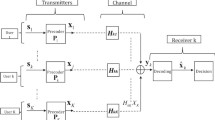Abstract
We consider the interference alignment (IA) in the three user constant multiple input multiple output (MIMO) interference channel. A two branch transmit and receive beam-forming scheme is proposed, where the IA scheme of Cadambe and Jafar is applied to the top branches while the bottom branches help additional stream transmission without causing interference to the other users. This scheme is applicable without any restriction on the numbers of transmit and receive antennas and affords additional degree of freedom gain compared to the Cadambe and Jafar scheme. With the proposed scheme, the known degree of freedom upper bound \(\frac{3(M+N)}{4}\) of the beam-forming based IA is achieved in more general condition than the previous result for the three user constant MIMO interference channel, where \(M\) is the number of antennas at the transmitter and \(N\) is the number of antennas at the receivers.



Similar content being viewed by others
Notes
When \(M=N\) and they are odd numbers, the IA scheme in [2] uses pre-coding over two symbol durations to get two equal dimensional spaces, one for the signal reception and the other for the interference reception. However, this is different from symbol extension since they are not relying on time or frequency selectivity. In this correspondence , we also assume pre-coding over two symbol durations when we apply the IA in [2] to an odd numbered dimension.
\(J\ (0\le J\le \min (M,N))\) is an integer to be optimized in Sect. 3.
References
Bresler, G., Cartwright, D., & Tse, D. (2011). Settling the feasibility of interference alignment for the MIMO interference channel: The symmetric square case. arXiv:11040888.
Cadambe, V. R., & Jafar, S. A. (2008). Interference alignment and degrees of freedom of the k-user interfernce channel. IEEE Transactions on Information Theory, 54(8), 3425–3441.
Choi, S. W., Jafar, S. A., & Chung, S. Y. (2009). On the beamforming design for efficient interference alignment. IEEE Communications Letters, 13(11), 847–849.
Ghasemi, A., Motahari, A. S., & Khandani, A. K. (2010). Interference alignment for the k-user mimo interference channel. In: Proceedings of IEEE international symposium on information theory (ISIT), pp. 360–364.
Gomadam, K., Cadambe, V. R., & Jafar, S. A. (2008). Approaching the capacity of wireless networks through distributed interference alignment. In: IEEE Globecom, pp. 4260–4265.
Gomadam, K., Cadambe, V. R., & Jafar, S. A. (2011). A distributed numerical approach to interference alignment and application to wireless interference networks. IEEE Transactions on Information Theory, 57(6), 3309–3321.
Gou, T., & Jafar, S. A. (2010). Degrees of freedom of the k user \(m\times n\) MIMO interference channel. IEEE Transactions on Information Theory, 56(12), 6040–6057.
Hwang, D. (2012). Interference alignment for the multi-cell multiuser interference channel. IEEE Communications Letters, 16(6), 831–833.
Jafar, S. A., & Fakhereddin, M. J. (2007). Degrees of freedom for the MIMO interference channel. IEEE Transactions on Information Theory, 53(7), 2637–2642.
Jafar, S. A., & Shamai, S. (2008). Degrees of freedom region of the MIMO x channel. IEEE Transactions on Information Theory, 54(1), 151–170.
Khalil, M., El-Keyi, A., & Nafie, M. (2012). A new achievable dof region for the 3-user m n symmetric interference channel. In Proceedings of IEEE international conference on communications (ICC), pp. 2238–2243.
Kim, J., Park, S. H., Sung, H., & Lee, I. (2010). Spatial multiplexing gain for two interfering MIMO broadcast channels based on linear transceiver. IEEE Transactions on Wireless Communications, 9(10), 3012–3017.
Kim, T., Love, D., Clerckx, B., & Hwang, D. (2011). Spatial degree of freedom of the multicell MIMO multiple access channel. In Proceedings of IEEE Globecom, pp. 1–5.
Razaviyayn, M., Lyubeznik, G., & Luo, Z. (2012). On the degrees of freedom achievable through interference alignment in a MIMO interference channel. IEEE Transactions on Signal Processing, 60(2), 812–821.
Suh, C., & Tse, D. (2008). Interference alignment for cellular networks. In Proceedings on Allerton conference on communication, control, and computing, pp. 1037–1044.
Suh, C., Tse, D., & Ho, M. (2010). Downlink interference alignment. In Proceedings of IEEE Globecom, pp. 1–5.
Sung, H., Park, S. H., Lee, K. J., & Lee, I. (2010). Linear precoder designs for k-user interference channels. IEEE Transactions on Wireless Communications, 9(1), 291–301.
Yetis, C. M., Guo, T., Jafar, S., & Kayran, A. H. (2010). On feasibility of interference alignment in MIMO interference networks. IEEE Transactions on Signal Processing, 58(9), 4771–4782.
Acknowledgments
This work was supported by the National Research Foundation of Korea (NRF) grant funded by the Korean government (MSIP) (2014R1A5A1011478), and Basic Science Research Program through the NRF funded by the Ministry of Education (NRF-2010-0020210).
Author information
Authors and Affiliations
Corresponding author
Rights and permissions
About this article
Cite this article
Hwang, D., Lee, TJ. Two Branch Beamforming for the Three User Constant MIMO Interference Channel. Wireless Pers Commun 80, 1251–1261 (2015). https://doi.org/10.1007/s11277-014-2085-4
Published:
Issue Date:
DOI: https://doi.org/10.1007/s11277-014-2085-4




